AWS Certified Security - Specialty Questions and Answers
A company used AWS Organizations to set up an environment with multiple AWS accounts. The company's organization currently has two AWS accounts, and the companyexpects to add more than 50 AWS accounts during the next 12 months The company will require all existing and future AWS accounts to use Amazon GuardDuty. Eachexisting AWS account has GuardDuty active. The company reviews GuardDuty findings by logging into each AWS account individually.
The company wants a centralized view of the GuardDuty findings for the existing AWS accounts and any future AWS accounts. The company also must ensure that anynew AWS account has GuardDuty automatically turned on.
Which solution will meet these requirements?
A company has deployed AWS Control Tower and an organization in AWS Organizations to manage its AWS accounts. The company needs to implement the AWS Foundational Security Best Practices standard and must centrally log findings for the organization into one account.
Which solution will meet these requirements?
A company has a guideline that mandates the encryption of all Amazon S3 bucket data in transit. A security engineer must implement an S3 bucket policy that denies any S3 operations if data is not encrypted.
Which S3 bucket policy will meet this requirement?
A team is using AWS Secrets Manager to store an application database password. Only a limited number of IAM principals within the account can have access to the secret. The principals who require access to the secret change frequently. A security engineer must create a solution that maximizes flexibility and scalability.
Which solution will meet these requirements?
A company is using AWS WAF to protect a customized public API service that is based on Amazon EC2 instances. The API uses an Application Load Balancer.
The AWS WAF web ACL is configured with an AWS Managed Rules rule group. After a software upgrade to the API and the client application, some types of requests are no longer working and are causing application stability issues. A security engineer discovers that AWS WAF logging is not turned on for the web ACL.
The security engineer needs to immediately return the application to service, resolve the issue, and ensure that logging is not turned off in the future. The security engineer turns on logging for the web ACL and specifies Amazon Cloud-Watch Logs as the destination.
Which additional set of steps should the security engineer take to meet the re-quirements?
A company hosts a public website on an Amazon EC2 instance. HTTPS traffic must be able to access the website. The company uses SSH for management of the web server.
The website is on the subnet 10.0.1.0/24. The management subnet is 192.168.100.0/24. A security engineer must create a security group for the EC2
instance.
Which combination of steps should the security engineer take to meet these requirements in the MOST secure manner? (Select TWO.)
A company plans to create Amazon S3 buckets to store log data. All the S3 buckets will have versioning enabled and will use the S3 Standard storage class.
A security engineer needs to implement a solution that protects objects in the S3 buckets from deletion for 90 days. The solution must ensure that no object can be deleted during this time period, even by an administrator or the AWS account root user.
Which solution will meet these requirements?
A company operates a web application that runs on Amazon EC2 instances. The application listens on port 80 and port 443. The company uses an Application Load Balancer (ALB) with AWS WAF to terminate SSL and to forward traffic to the application instances only on port 80.
The ALB is in public subnets that are associated with a network ACL that is named NACL1. The application instances are in dedicated private subnets that are associated with a network ACL that is named NACL2. An Amazon RDS for PostgreSQL DB instance that uses port 5432 is in a dedicated private subnet that is associated with a network ACL that is named NACL3. All the network ACLs currently allow all inbound and outbound traffic.
Which set of network ACL changes will increase the security of the application while ensuring functionality?
A Systems Engineer is troubleshooting the connectivity of a test environment that includes a virtual security appliance deployed inline. In addition to using the virtual security appliance, the Development team wants to use security groups and network ACLs to accomplish various security requirements in the environment.
What configuration is necessary to allow the virtual security appliance to route the traffic?
A company is evaluating the use of AWS Systems Manager Session Manager to gam access to the company's Amazon EC2 instances. However, until the company implements the change, the company must protect the key file for the EC2 instances from read and write operations by any other users.
When a security administrator tries to connect to a critical EC2 Linux instance during an emergency, the security administrator receives the following error. "Error Unprotected private key file - Permissions for' ssh/my_private_key pern' are too open".
Which command should the security administrator use to modify the private key Me permissions to resolve this error?
A company has several Amazon S3 buckets thai do not enforce encryption in transit A security engineer must implement a solution that enforces encryption in transit for all the company's existing and future S3 buckets.
Which solution will meet these requirements'?
A company has an application on Amazon EC2 instances that store confidential customer data. The company must restrict access to customer data. A security engineer requires secure access to the instances that host the application. According to company policy, users must not open any inbound ports, maintain bastion hosts, or manage SSH keys for the EC2 instances.
The security engineer wants lo monitor, store, and access all session activity logs. The logs must be encrypted.
Which solution will meet these requirements?
A company hosts a web application on an Apache web server. The application runs on Amazon EC2 instances that are in an Auto Scaling group. The company configured the EC2 instances to send the Apache web server logs to an Amazon CloudWatch Logs group that the company has configured to expire after 1 year.
Recently, the company discovered in the Apache web server logs that a specific IP address is sending suspicious requests to the web application. A security engineer wants to analyze the past week of Apache web server logs to determine how many requests that the IP address sent and the corresponding URLs that the IP address requested.
What should the security engineer do to meet these requirements with the LEAST effort?
A company that uses GitHub Actions needs to use a workflow to deploy AWS services. A security engineer must set up authentication between the GitHub Actions workflow and the company's AWS account.
The solution must involve no static credentials and no long-lived credentials for access to AWS Additionally, the workflow must be able to run without requiring any manual changes.
Which solution will meet these requirements?
A company wants to know when users make changes to IAM roles in the company's AWS account. The company uses Amazon CloudWatch and AWS CloudTrail in the account. The company has configured a CloudTrail trail to capture read and write API activity for management events. The company has an Amazon Simple Notification Service (Amazon SNS) topic for security notifications.
A security engineer must implement a solution that provides a notification when an IAM role is edited.
Which solution will meet this requirement?
A company needs to encrypt all of its data stored in Amazon S3. The company wants to use IAM Key Management Service (IAM KMS) to create and manage its encryption keys. The company's security policies require the ability to Import the company's own key material for the keys, set an expiration date on the keys, and delete keys immediately, if needed.
How should a security engineer set up IAM KMS to meet these requirements?
A security engineer is designing a solution that will provide end-to-end encryption between clients and Docker containers running in Amazon Elastic Container Service (Amazon ECS). This solution will also handle volatile traffic patterns.
Which solution would have the MOST scalability and LOWEST latency?
A company has multiple accounts in the AWS Cloud. Users in the developer account need to have access to specific resources in the production account.
What is the MOST secure way to provide this access?
A company has launched an Amazon EC2 instance with an Amazon Elastic Block Store(Amazon EBS) volume in the us-east-1 Region The volume is encrypted with an AWS Key Management Service (AWS KMS) customer managed key that the company's security team created The security team has created an 1AM key policy and has assigned the policy to the key The security team has also created an 1AM instance profile and has assigned the profile to the instance
The EC2 instance will not start and transitions from the pending state to the shutting-down state to the terminated state
Which combination of steps should a security engineer take to troubleshoot this issue? (Select TWO )
A Network Load Balancer (NLB) target instance is not entering the InService state. A security engineer determines that health checks are failing.
Which factors could cause the health check failures? (Select THREE.)
A company has AWS accounts in an organization in AWS Organizations. The organization includes a dedicated security account.
All AWS account activity across all member accounts must be logged and reported to the dedicated security account. The company must retain all the activity logs in a secure storage location within the dedicated security account for 2 years. No changes or deletions of the logs are allowed.
Which combination of steps will meet these requirements with the LEAST operational overhead? (Select TWO.)
A company needs to improve its ability to identify and prevent IAM policies that grant public access or cross-account access to resources. The company has implemented AWS Organizations and has started using AWS Identity and Access Management Access Analyzer to refine overly broad access to accounts in the organization.
A security engineer must automate a response in the company's organization for any newly created policies that are overly permissive. The automation must remediate external access and must notify the company's security team.
Which combination of steps should the security engineer take to meet these requirements? (Select THREE.)
A company has a requirement that no Amazon EC2 security group can allow SSH access from the CIDR block 0.0.0.070. The company wants to monitor compliance with this requirement at all times and wants to receive a near-real-time notification if any security group is noncompliant.
A security engineer has configured AWS Config and will use the restricted-ssh managed rule to monitor the security groups.
What should the security engineer do next to meet these requirements?
A company has several workloads running on AWS. Employees are required to authenticate using on-premises ADFS and SSO to access the AWS Management
Console. Developers migrated an existing legacy web application to an Amazon EC2 instance. Employees need to access this application from anywhere on the internet, but currently, there is no authentication system built into the application.
How should the Security Engineer implement employee-only access to this system without changing the application?
A company needs to implement data lifecycle management for Amazon RDS snapshots. The company will use AWS Backup to manage the snapshots.
The company must retain RDS automated snapshots for 5 years and will use Amazon S3 for long-term archival storage.
Which solution will meet these requirements?
A company is running an Amazon RDS for MySQL DB instance in a VPC. The VPC must not send or receive network traffic through the internet.
A security engineer wants to use AWS Secrets Manager to rotate the DB instance credentials automatically. Because of a security policy, the security engineer cannot use the standard AWS Lambda function that Secrets Manager provides to rotate the credentials.
The security engineer deploys a custom Lambda function in the VPC. The custom Lambda function will be responsible for rotating the secret in Secrets Manager. The security engineer edits the DB instance's security group to allow connections from this function. When the function is invoked, the function cannot communicate with Secrets Manager to rotate the secret properly.
What should the security engineer do so that the function can rotate the secret?
A company has a new partnership with a vendor. The vendor will process data from the company's customers. The company will upload data files as objects into an Amazon S3 bucket. The vendor will download the objects to perform data processing. The objects will contain sensi-tive data.
A security engineer must implement a solution that prevents objects from resid-ing in the S3 bucket for longer than 72 hours.
Which solution will meet these requirements?
A development team is attempting to encrypt and decode a secure string parameter from the IAM Systems Manager Parameter Store using an IAM Key Management Service (IAM KMS) CMK. However, each attempt results in an error message being sent to the development team.
Which CMK-related problems possibly account for the error? (Select two.)
A company is running its workloads in a single AWS Region and uses AWS Organizations. A security engineer must implement a solution to prevent users from launching resources in other Regions.
Which solution will meet these requirements with the LEAST operational overhead?
A company is migrating its Amazon EC2 based applications to use Instance Metadata Service Version 2 (IMDSv2). A security engineer needs to determine whether any of the EC2 instances are still using Instance Metadata Service Version 1 (IMDSv1).
What should the security engineer do to confirm that the IMDSv1 endpoint is no longer being used?
A company is using AWS Organizations with nested OUs to manage AWS accounts. The company has a custom compliance monitoring service for the accounts. The monitoring service runs as an AWS Lambda function and is invoked by Amazon EventBridge Scheduler.
The company needs to deploy the monitoring service in all existing and future accounts in the organization. The company must avoid using the organization's management account when the management account is not required.
Which solution will meet these requirements?
A company hosts its microservices application on Amazon Elastic Kubernetes Service (Amazon EKS). The company has set up continuous deployments to update the application on demand. A security engineer must implement a solution to provide automatic detection of anomalies in application logs in near real time. The solution also must send notifications about these anomalies to the security team. Which solution will meet these requirements?
An ecommerce website was down for 1 hour following a DDoS attack. Users were unable to connect to the website during the attack period. The ecommerce company's security team is worried about future potential attacks and wants to prepare for such events. The company needs to minimize downtime in its response to similar attacks in the future.
Which steps would help achieve this? (Select TWO.)
A company is building an application on IAM that will store sensitive Information. The company has a support team with access to the IT infrastructure, including databases. The company's security engineer must introduce measures to protect the sensitive data against any data breach while minimizing management overhead. The credentials must be regularly rotated.
What should the security engineer recommend?
A business requires a forensic logging solution for hundreds of Docker-based apps running on Amazon EC2. The solution must analyze logs in real time, provide message replay, and persist logs.
Which Amazon Web Offerings (IAM) services should be employed to satisfy these requirements? (Select two.)
A company has public certificates that are managed by AWS Certificate Manager (ACM). The certificates are either imported certificates or managed certificates from ACM with mixed validation methods. A security engineer needs to design a monitoring solution to provide alerts by email when a certificate is approaching its expiration date.
What is the MOST operationally efficient way to meet this requirement?
A security engineer has been asked to troubleshoot inbound connectivity to a web server. This single web server is not receiving inbound connections from the internet, whereas all other web servers are functioning properly.
The architecture includes network ACLs, security groups, and a virtual security appliance. In addition, the development team has implemented Application Load Balancers (ALBs) to distribute the load across all web servers. It is a requirement that traffic between the web servers and the internet flow through the virtual security appliance.
The security engineer has verified the following:
The rule set in the security groups is correct.
The rule set in the network ACLs is correct.
The rule set in the virtual appliance is correct.
Which of the following are other valid items to troubleshoot in this scenario? (Select TWO.)
A security engineer recently rotated the host keys for an Amazon EC2 instance. The security engineer is trying to access the EC2 instance by using the EC2 Instance. Connect feature. However, the security engineer receives an error (or failed host key validation. Before the rotation of the host keys EC2 Instance Connect worked correctly with this EC2 instance.
What should the security engineer do to resolve this error?
A company is expanding its group of stores. On the day that each new store opens, the company wants to launch a customized web application for that store. Each store's application will have a non-production environment and a production environment. Each environment will be deployed in a separate AWS account. The company uses AWS Organizations and has an OU that is used only for these accounts.
The company distributes most of the development work to third-party development teams. A security engineer needs to ensure that each team follows the company's
deployment plan for AWS resources. The security engineer also must limit access to the deployment plan to only the developers who need access. The security engineer already has created an AWS CloudFormation template that implements the deployment plan.
What should the security engineer do next to meet the requirements in the MOST secure way?
A company is using AWS Organizations to manage multiple AWS accounts for its human resources, finance, software development, and production departments. All the company's developers are part of the software development AWS account.
The company discovers that developers have launched Amazon EC2 instances that were preconfigured with software that the company has not approved for use. The company wants to implement a solution to ensure that developers can launch EC2 instances with only approved software applications and only in the software development AWS account.
Which solution will meet these requirements?
A company needs complete encryption of the traffic between external users and an application. The company hosts the application on a fleet of Amazon EC2 instances that run in an Auto Scaling group behind an Application Load Balancer (ALB).
How can a security engineer meet these requirements?
A security engineer is configuring account-based access control (ABAC) to allow only specific principals to put objects into an Amazon S3 bucket. The principalsalready have access to Amazon S3.
The security engineer needs to configure a bucket policy that allows principals to put objects into the S3 bucket only if the value of the Team tag on the object matches the value of the Team tag that is associated with the principal. During testing, the security engineer notices that a principal can still put objects into the S3 bucket when the tag values do not match.
Which combination of factors are causing the PutObject operation to succeed when the tag values are different? (Select TWO.)
A company wants to establish separate IAM Key Management Service (IAM KMS) keys to use for different IAM services. The company'ssecurityengineer created the following key policy lo allow the infrastructure deployment team to create encrypted Amazon Elastic Block Store (Amazon EBS) volumes by assuming the InfrastructureDeployment IAM role:
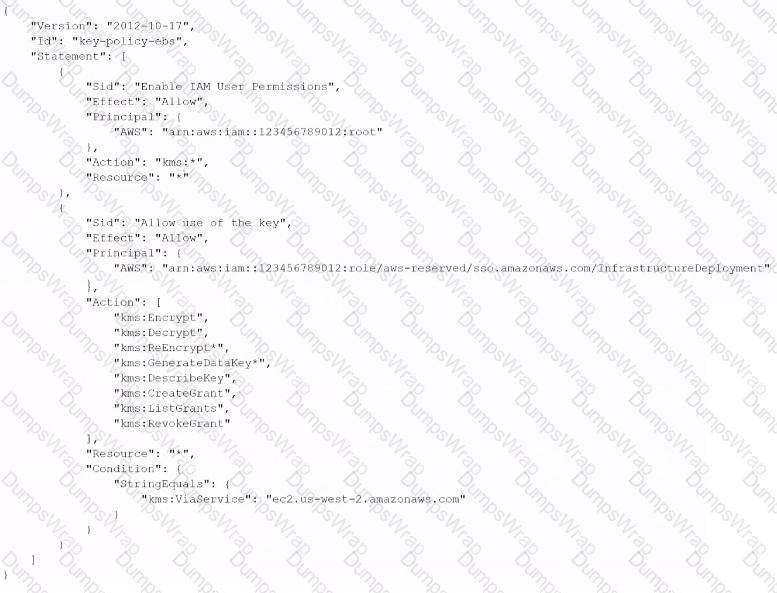
The security engineer recently discovered that IAM roles other than the InfrastructureDeployment role used this key (or other services. Which change to the policy should the security engineer make to resolve these issues?
A security engineer discovers that a company's user passwords have no required minimum length. The company is using the following two identity providers (IdPs):
• AWS Identity and Access Management (1AM) federated with on-premises Active Directory
• Amazon Cognito user pools that contain the user database for an AWS Cloud application that the company developed
Which combination of actions should the security engineer take to implement a required minimum length for the passwords? (Select TWO.)
A company wants to remove all SSH keys permanently from a specific subset of its Amazon Linux 2 Amazon EC2 instances that are using the same 1AM instance profile However three individuals who have IAM user accounts will need to access these instances by using an SSH session to perform critical duties
How can a security engineer provide the access to meet these requirements'?
A company uses an organization in AWS Organizations to manage its AWS accounts. The company has implemented a Service Control Policy (SCP) in the root account to prevent resources from being shared with external accounts.
The company now needs to allow applications in its marketing team's AWS account to share resources with external accounts. The company must continue to prevent all the other accounts in the organization from sharing resources with external accounts. All the accounts in the organization are members of the same Organizational Unit (OU).
Which solution will meet these requirements?
Which of the following bucket policies will ensure that objects being uploaded to a bucket called 'demo' are encrypted.
Please select:
A security engineer needs to implement a solution to create and control the keys that a company uses for cryptographic operations. The security engineer must create symmetric keys in which the key material is generated and used within a custom key store that is backed by an AWS CloudHSM cluster.
The security engineer will use symmetric and asymmetric data key pairs for local use within applications. The security engineer also must audit the use of the keys.
How can the security engineer meet these requirements?
A company runs a cron job on an Amazon EC2 instance on a predefined schedule The cron job calls a bash script that encrypts a 2 KB file. A security engineer creates an AWS Key Management Service (AWS KMS) customer managed key with a key policy. The key policy and the EC2 instance rote have the necessary configuration for this job.
Which process should the bash script use to encrypt the file?
A corporation is preparing to acquire several companies. A Security Engineer must design a solution to ensure that newly acquired IAM accounts follow the corporation's security best practices. The solution should monitor each Amazon S3 bucket for unrestricted public write access and use IAM managed services.
What should the Security Engineer do to meet these requirements?
A company's application team wants to replace an internal application with a new IAM architecture that consists of Amazon EC2 instances, an IAM Lambda function, and an Amazon S3 bucket in a single IAM Region. After an architecture review, the security team mandates that no application network traffic can traverse the public internet at any point. The security team already has an SCP in place for the company's organization in IAM Organizations to restrict the creation of internet gateways. NAT gateways, and egress-only gateways.
Which combination of steps should the application team take to meet these requirements? (Select THREE.)
A security engineer for a large company is managing a data processing application used by 1.500 subsidiary companies. The parent and subsidiary companies all use AWS. The application uses TCP port 443 and runs on Amazon EC2 behind a Network Load Balancer (NLB). For compliance reasons, the application should only be accessible to the subsidianes and should not be available on the public internet. To meet the compliance requirements for restricted access, the engineer has received the public and private CIDR block ranges for each subsidiary.
What solution should the engineer use to implement the appropriate access restrictions for the application?
A company that uses AWS Organizations is migrating workloads to AWS. The compa-nys application team determines that the workloads will use Amazon EC2 instanc-es, Amazon S3 buckets, Amazon DynamoDB tables, and Application Load Balancers. For each resource type, the company mandates that deployments must comply with the following requirements:
• All EC2 instances must be launched from approved AWS accounts.
• All DynamoDB tables must be provisioned with a standardized naming convention.
• All infrastructure that is provisioned in any accounts in the organization must be deployed by AWS CloudFormation templates.
Which combination of steps should the application team take to meet these re-quirements? (Select TWO.)
A security engineer wants to evaluate configuration changes to a specific AWS resource to ensure that the resource meets compliance standards. However, the security engineer is concerned about a situation in which several configuration changes are made to the resource in quick succession. The security engineer wants to record only the latest configuration of that resource to indicate the cumulative impact of the set of changes.
Which solution will meet this requirement in the MOST operationally efficient way?
A security engineer received an Amazon GuardDuty alert indicating a finding involving the Amazon EC2 instance that hosts the company's primary website. The GuardDuty finding read:
UnauthorizedAccess: IAMUser/InstanceCredentialExfiltration.
The security engineer confirmed that a malicious actor used API access keys intended for the EC2 instance from a country where the company does not operate. The security engineer needs to deny access to the malicious actor.
What is the first step the security engineer should take?
To meet regulatory requirements, a Security Engineer needs to implement an IAM policy that restricts the use of AWS services to the us-east-1 Region.
What policy should the Engineer implement?
A company needs to create a centralized solution to analyze log files. The company uses an organization in AWS Organizations to manage its AWS accounts.
The solution must aggregate and normalize events from the following sources:
• The entire organization in Organizations
• All AWS Marketplace offerings that run in the company’s AWS accounts
• The company's on-premises systems
Which solution will meet these requirements?
A security engineer must troubleshoot an administrator's inability to make an existingAmazon S3 bucket public in an account that is part of an organization n IAM Organizations. The administrator switched the role from the master account to a member account and then attempted to make one S3 bucket public. This action was immediately denied
Which actions should the security engineer take to troubleshoot the permissions issue? (Select TWO.)
A company needs to delect unauthenticated access to its Amazon Elastic Kubernetes Service (Amazon EKS) clusters. The company needs a solution that requires no additional configuration ot the existing EKS deployment.
Which solution will meet these requirements with the LEAST operational effort?
Example.com is hosted on Amazon EC2 instances behind an Application Load Balancer (ALB). Third-party host intrusion detection system (HIDS) agents that capture the traffic of the EC2 instance are running on each host. The company must ensure they are using privacy enhancing technologies for users, without losing the assurance the third-party solution offers.
What is the MOST secure way to meet these requirements?
A company is implementing a customized notification solution to detect repeated unauthorized authentication attempts to bastion hosts. The company's security engineer needs to implement a solution that will provide notification when 5 failed attempts occur within a 5-minute period. The solution must use native AWS services and must notify only the designated system administrator who is assigned to the specific bastion host.
Which solution will meet these requirements?
A company's Security Engineer has been tasked with restricting a contractor's IAM account access to the company's Amazon EC2 console without providing access to any other AWS services. The contractor's IAM account must not be able to gain access to any other AWS service, even if the IAM account is assigned additional permissions based on IAM group membership.
What should the Security Engineer do to meet these requirements?
A company has hundreds of AWS accounts and uses AWS Organizations. The company plans to create many different IAM roles and policies for its product team, security team, and platform team. Some IAM policies will be shared across teams.
A security engineer needs to implement a solution to logically group together the IAM roles of each team. The solution must allow only the platform team to delegate IAM permissions to AWS services.
Which solution will meet these requirements?
A security engineer is creating an AWS Lambda function. The Lambda function needs to use a role that is named LambdaAuditRole to assume a role that is named AcmeAuditFactoryRole in a different AWS account.
When the code is processed, the following error message appears: "An error oc-curred (AccessDenied) when calling the AssumeRole operation."
Which combination of steps should the security engineer take to resolve this er-ror? (Select TWO.)
A company has created a set of AWS Lambda functions to automate incident response steps for incidents that occur on Amazon EC2 instances. The Lambda functions need to collect relevant artifacts, such as instance ID and security group configuration. The Lambda functions must then write a summary to an Amazon S3 bucket.
The company runs its workloads in a VPC that uses public subnets and private subnets. The public subnets use an internet gateway to access the internet. The private subnets use a NAT gateway to access the internet.
All network traffic to Amazon S3 that is related to the incident response process must use the AWS network. This traffic must not travel across the internet.
Which solution will meet these requirements?
A developer signed in to a new account within an IAM Organization organizational unit (OU) containing multiple accounts. Access to the Amazon $3 service is restricted with the following SCP.
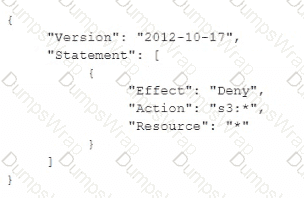
How can the security engineer provide the developer with Amazon $3 access without affecting other account?
A company has an organization in AWS Organizations. The company wants to use AWS CloudFormation StackSets in the organization to deploy various AWS design patterns into environments. These patterns consist of Amazon EC2 instances, Elastic Load Balancing (ELB) load balancers, Amazon RDS databases, and Amazon Elastic Kubernetes Service (Amazon EKS) clusters or Amazon Elastic Container Service (Amazon ECS) clusters.
Currently, the company's developers can create their own CloudFormation stacks to increase the overall speed of delivery. A centralized CI/CD pipeline in a shared services AWS account deploys each CloudFormation stack.
The company's security team has already provided requirements for each service in accordance with internal standards. If there are any resources that do not comply with the internal standards, the security team must receive notification to take appropriate action. The security team must implement a notification solution that gives developers the ability to maintain the same overall delivery speed that they currently have.
Which solution will meet these requirements in the MOST operationally efficient way?
A company wants to migrate its static primary domain website to AWS. The company hosts the website and DNS servers internally. The company wants the website to enforce SSL/TLS encryption block IP addresses from outside the United States (US), and take advantage of managed services whenever possible.
Which solution will meet these requirements?
A company's security engineer is developing an incident response plan to detect suspicious activity in an AWS account for VPC hosted resources. The security engineer needs to provide visibility for as many AWS Regions as possible.
Which combination of steps will meet these requirements MOST cost-effectively? (Select TWO.)
A company uses an organization in AWS Organizations to help separate its Amazon EC2 instances and VPCs. The company has separate OUs for development workloads and production workloads.
A security engineer must ensure that only AWS accounts in the production OU can write VPC flow logs to an Amazon S3 bucket. The security engineer is configuring the S3 bucket policy with a Condition element to allow the s3 PutObject action for VPC flow logs.
How should the security engineer configure the Condition element to meet these requirements?
A company is running an application on Amazon EC2 instances in an Auto Scaling group. The application stores logs locally. A security engineer noticed that logs were lost after a scale-in event. The security engineer needs to recommend a solution to ensure the durability and availability of log data All logs must be kept for a minimum of 1 year for auditing purposes. What should the security engineer recommend?
A company runs a web application on a fleet of Amazon EC2 instances behind an Application Load Balancer (ALB). The ALB is associated with an AWS WAF web ACL that includes several AWS managed rules in Block mode The ALB and the web ACL are configured to send togs to Amazon S3 Additionally, the web application sends requests to a log group in Amazon CloudWatch Logs.
The web ACL is blocking a specific request to the web application. A security engineer must determine which web ACL rule is blocking the request
Which solution will provide this information?
A security engineer receives an IAM abuse email message. According to the message, an Amazon EC2 instance that is running in the security engineer's IAM account is sending phishing email messages.
The EC2 instance is part of an application that is deployed in production. The application runs on many EC2 instances behind an Application Load Balancer. The instances run in an AmazonEC2 Auto Scaling group across multiple subnets and multiple Availability Zones.
The instances normally communicate only over the HTTP. HTTPS, and MySQL protocols. Upon investigation, the security engineer discovers that email messages are being sent over port 587. All other traffic is normal.
The security engineer must create a solution that contains the compromised EC2 instance, preserves forensic evidence for analysis, and minimizes application downtime. Which combination of steps must the security engineer take to meet these requirements? (Select THREE.)
A company has a batch-processing system that uses Amazon S3, Amazon EC2, and AWS Key Management Service (AWS KMS). The system uses two AWS accounts: Account A and Account B.
Account A hosts an S3 bucket that stores the objects that will be processed. The S3 bucket also stores the results of the processing. All the S3 bucket objects are encrypted by a KMS key that is managed in
Account A.
Account B hosts a VPC that has a fleet of EC2 instances that access the S3 buck-et in Account A by using statements in the bucket policy. The VPC was created with DNS hostnames enabled and DNS resolution enabled.
A security engineer needs to update the design of the system without changing any of the system's code. No AWS API calls from the batch-processing EC2 in-stances can travel over the internet.
Which combination of steps will meet these requirements? (Select TWO.)
A company Is planning to use Amazon Elastic File System (Amazon EFS) with its on-premises servers. The company has an existing IAM Direct Connect connection established between its on-premises data center and an IAM Region Security policy states that the company's on-premises firewall should only have specific IP addresses added to the allow list and not a CIDR range. The company also wants to restrict access so that only certain data center-based servers have access to Amazon EFS
How should a security engineer implement this solution''
A security engineer is working with a company to design an ecommerce application. The application will run on Amazon EC2 instances that run in an Auto Scaling group behind an Application Load Balancer (ALB). The application will use an Amazon RDS DB instance for its database.
The only required connectivity from the internet is for HTTP and HTTPS traffic to the application. The application must communicate with an external payment provider that allows traffic only from a preconfigured allow list of IP addresses. The company must ensure that communications with the external payment provider are not interrupted as the environment scales.
Which combination of actions should the security engineer recommend to meet these requirements? (Select THREE.)
A security engineer is defining the controls required to protect the IAM account root user credentials in an IAM Organizations hierarchy. The controls should also limit the impact in case these credentials have been compromised.
Which combination of controls should the security engineer propose?(Select THREE.)
A)

B)
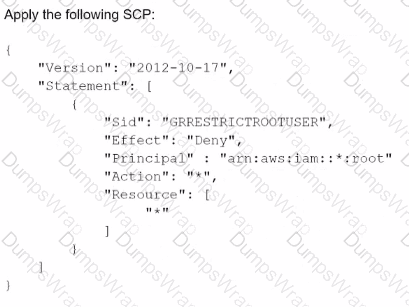
C) Enable multi-factor authentication (MFA) for the root user.
D) Set a strong randomized password and store it in a secure location.
E) Create an access key ID and secret access key, and store them in a secure location.
F) Apply the following permissions boundary to the toot user:
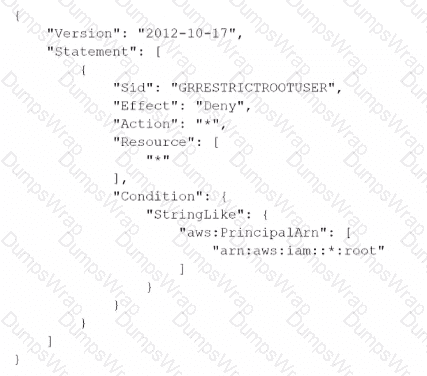
A company became aware that one of its access keys was exposed on a code sharing website 11 days ago. A Security Engineer must review all use of the exposed access keys to determine the extent of the exposure. The company enabled IAM CloudTrail m an regions when it opened the account
Which of the following will allow (he Security Engineer 10 complete the task?
A company wants to configure DNS Security Extensions (DNSSEC) for the company's primary domain. The company registers the domain with Amazon Route 53. The company hosts the domain on Amazon EC2 instances by using BIND.
What is the MOST operationally efficient solution that meets this requirement?
A security engineer is designing security controls for a fleet of Amazon EC2 instances that run sensitive workloads in a VPC. The security engineer needs to implement a solution to detect and mitigate software vulnerabilities on the EC2 instances.
Which solution will meet this requirement?
A company has an application that processes personally identifiable information (Pll). The application runs on Amazon EC2 instances behind an Application Load Balancer (ALB). The company's security policies require that data is encrypted in transit at all times to avoid the possibility of exposing any Pll in plaintext.
Which solutions could a security engineer use to meet these requirements'? (Select TWO )
A company's engineering team is developing a new application that creates IAM Key Management Service (IAM KMS) CMK grants for users immediately after a grant IS created users must be able to use the CMK tu encrypt a 512-byte payload. During load testing, a bug appears |intermittently where AccessDeniedExceptions are occasionally triggered when a userfirst attempts to encrypt using the CMK
Which solution should the c0mpany‘s security specialist recommend‘?
A company deploys a set of standard IAM roles in AWS accounts. The IAM roles are based on job functions within the company. To balance operational efficiency and security, a security engineer implemented AWS Organizations SCPs to restrict access to critical security services in all company accounts.
All of the company's accounts and OUs within AWS Organizations have a default FullAWSAccess SCP that is attached. The security engineer needs to ensure that no one can disable Amazon GuardDuty and AWS Security Hub. The security engineer also must not override other permissions that are granted by IAM policies that are defined in the accounts.
Which SCP should the security engineer attach to the root of the organization to meet these requirements?
A company has two IAM accounts within IAM Organizations. In Account-1. Amazon EC2 Auto Scaling is launched using a service-linked role. In Account-2. Amazon EBS volumes are encrypted with an IAM KMS key A Security Engineer needs to ensure that the service-linked role can launch instances with these encrypted volumes
Which combination of steps should the Security Engineer take in both accounts? (Select TWO.)
A company hosts an application on Amazon EC2 that is subject to specific rules for regulatory compliance. One rule states that traffic to and from the workload must be inspected for network-level attacks. This involves inspecting the whole packet.
To comply with this regulatory rule, a security engineer must install intrusion detection software on a c5n.4xlarge EC2 instance. The engineer must then configure the software to monitor traffic to and from the application instances.
What should the security engineer do next?
An AWS account administrator created an IAM group and applied the following managed policy to require that each individual user authenticate using multi-factor authentication:
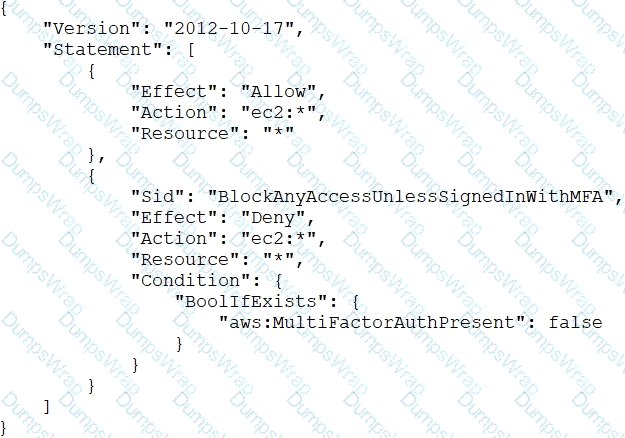
After implementing the policy, the administrator receives reports that users are unable to perform Amazon EC2 commands using the AWS CLI.
What should the administrator do to resolve this problem while still enforcing multi-factor authentication?
A business stores website images in an Amazon S3 bucket. The firm serves the photos to end users through Amazon CloudFront. The firm learned lately that the photographs are being accessible from nations in which it does not have a distribution license.
Which steps should the business take to safeguard the photographs and restrict their distribution? (Select two.)
An Incident Response team is investigating an IAM access key leak that resulted in Amazon EC2 instances being launched. The company did not discover the incident until many months later The Director of Information Security wants to implement new controls that will alert when similar incidents happen in the future
Which controls should the company implement to achieve this? {Select TWO.)
A company wants to monitor the deletion of customer managed CMKs A security engineer must create an alarm that will notify the company before a CMK is deleted The security engineer has configured the integration of IAM CloudTrail with Amazon CloudWatch
What should the security engineer do next to meet this requirement?
You have an S3 bucket defined in IAM. You want to ensure that you encrypt the data before sending it across the wire. What is the best way to achieve this.
Please select:
A company has several Amazon S3 buckets that do not enforce encryption in transit. A security engineer must implement a solution that enforces encryption in transit for all the company's existing and future S3 buckets.
Which solution will meet these requirements?
A company that uses AWS Organizations wants to see AWS Security Hub findings for many AWS accounts and AWS Regions. Some of the accounts are in the company's organization, and some accounts are in organizations that the company manages for customers. Although the company can see findings in the Security Hub administrator account for accounts in the company's organization, there are no findings from accounts in other organizations.
Which combination of steps should the company take to see findings from accounts that are outside the organization that includes the Security Hub administrator account? (Select TWO.)
A company suspects that an attacker has exploited an overly permissive role to export credentials from Amazon EC2 instance metadata. The company uses Amazon GuardDuty and AWS Audit Manager. The company has enabled AWS CloudTrail logging and Amazon CloudWatch logging for all of its AWS accounts.
A security engineer must determine if the credentials were used to access the company's resources from an external account.
Which solution will provide this information?
A company uses an external identity provider to allow federation into different IAM accounts. A security engineer for the company needs to identify the federated user that terminated a production Amazon EC2 instance a week ago.
What is the FASTEST way for the security engineer to identify the federated user?
A company has a new web-based account management system for an online game Players create a unique username and password to log in to the system.
The company has implemented an AWS WAF web ACL for the system. The web ACL includes the core rule set (CRS) AWS managed rule group on the Application Load Balancer that serves the system.
The company's security team finds that the system was the target of a credential stuffing attack Credentials that were exposed in other breaches were used to try to log in to the system
The security team must implement a solution to reduce the chance of a successful credential stuffing attack in the future The solution also must minimize impact on legitimate users of the system
Which combination of actions will meet these requirements? (Select TWO.)
A company uses identity federation to authenticate users into an identity account (987654321987) where the users assume an IAM role named IdentityRole. The users then assume an IAM role named JobFunctionRole in the target IAM account (123456789123) to perform their job functions.
A user is unable to assume the IAM role in the target account. The policy attached to the role in the identity account is:
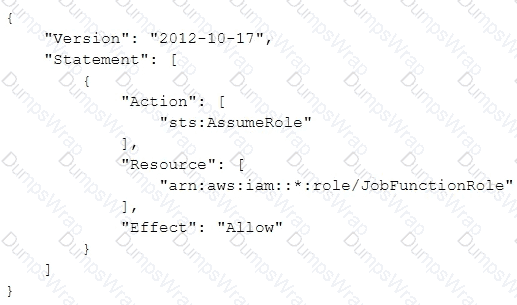
What should be done to enable the user to assume the appropriate role in the target account?
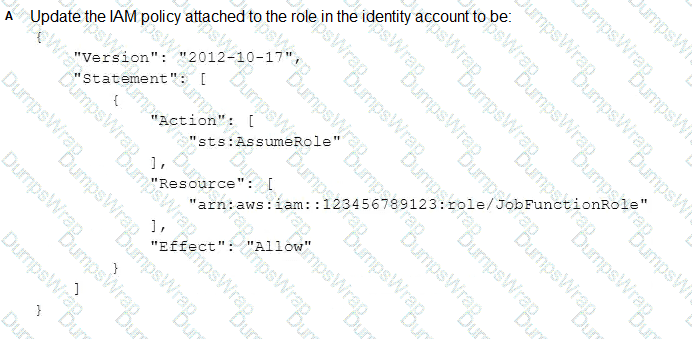

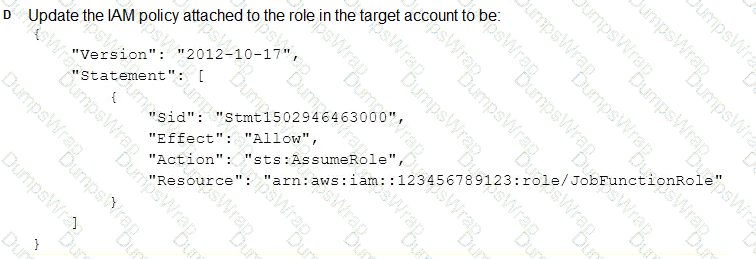
A company’s public Application Load Balancer (ALB) recently experienced a DDoS attack. To mitigate this issue. the company deployed Amazon CloudFront in front of the ALB so that users would not directly access the Amazon EC2 instances behind the ALB.
The company discovers that some traffic is still coming directly into the ALB and is still being handled by the EC2 instances.
Which combination of steps should the company take to ensure that the EC2 instances will receive traffic only from CloudFront? (Choose two.)
A company needs a forensic-logging solution for hundreds of applications running in Docker on Amazon EC2 The solution must perform real-time analytics on the togs must support the replay of messages and must persist the logs.
Which IAM services should be used to meet these requirements? (Select TWO)
An AWS account includes two S3 buckets: bucket1 and bucket2. The bucket2 does not have a policy defined, but bucket1 has the following bucket policy:
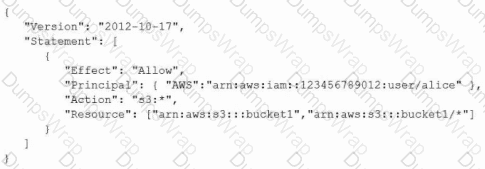
In addition, the same account has an IAM User named "alice", with the following IAM policy.

Which buckets can user "alice" access?
A Security Engineer is working with a Product team building a web application on AWS. The application uses Amazon S3 to host the static content, Amazon API
Gateway to provide RESTful services; and Amazon DynamoDB as the backend data store. The users already exist in a directory that is exposed through a SAML identity provider.
Which combination of the following actions should the Engineer take to enable users to be authenticated into the web application and call APIs? (Choose three.)
A company is running workloads on AWS. The workloads are in separate AWS accounts for development, testing, and production. All the company's developers can access the development account. A subset of the developers can access the testing account and the production account.
The company is spending too much time managing individual credentials for every developer across every environment. A security engineer must implement a more scalable solution that the company can use when a developer needs different access. The solution must allow developers to access resources across multiple accounts. The solution also must minimize credential sharing.
Which solution will meet these requirements?
A company's security engineer is designing an isolation procedure for Amazon EC2 instances as part of an incident response plan. The security engineer needs to isolate a target instance to block any traffic to and from the target instance, except for traffic from the company's forensics team. Each of the company's EC2 instances has its own dedicated security group. The EC2 instances are deployed in subnets of a VPC. A subnet can contain multiple instances.
The security engineer is testing the procedure for EC2 isolation and opens an SSH session to the target instance. The procedure starts to simulate access to the target instance by an attacker. The security engineer removes the existing security group rules and adds security group rules to give the forensics team access to the target instance on port 22.
After these changes, the security engineer notices that the SSH connection is still active and usable. When the security engineer runs a ping command to the public IP address of the target instance, the ping command is blocked.
What should the security engineer do to isolate the target instance?
A company needs to follow security best practices to deploy resources from an AWS CloudFormation template. The CloudFormation template must be able to configure sensitive database credentials.
The company already uses AWS Key Management Service (AWS KMS) and AWS Secrets Manager.
Which solution will meet the requirements?
A company is using IAM Organizations. The company wants to restrict IAM usage to the eu-west-1 Region for all accounts under an OU that is named "development." The solution must persist restrictions to existing and new IAM accounts under the development OU.
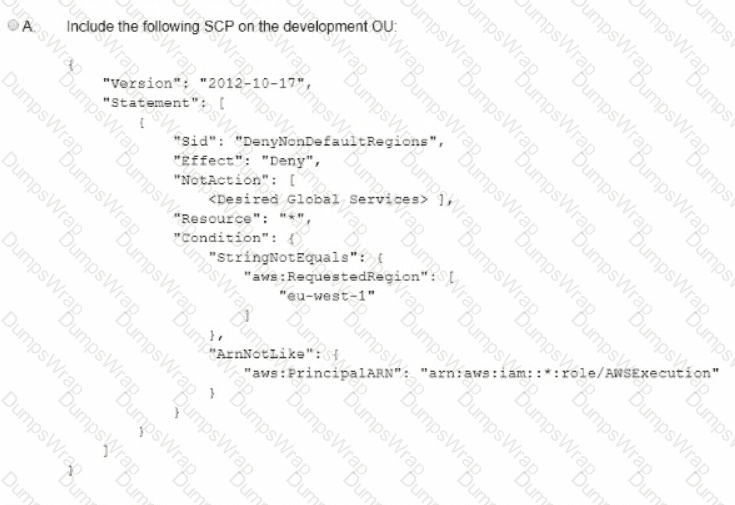
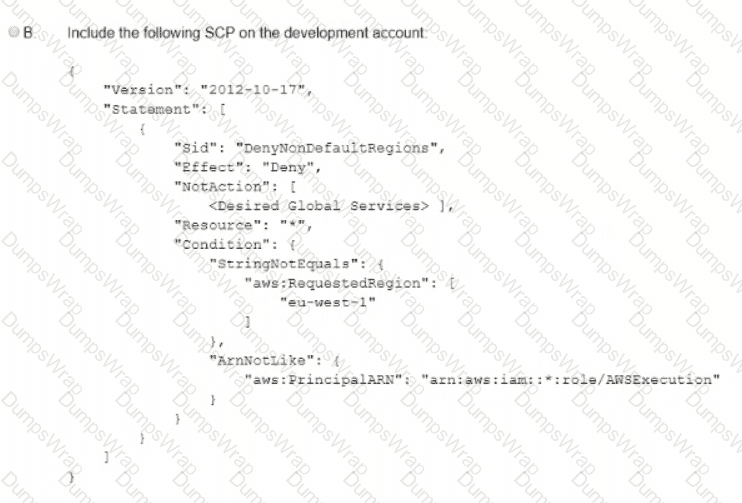

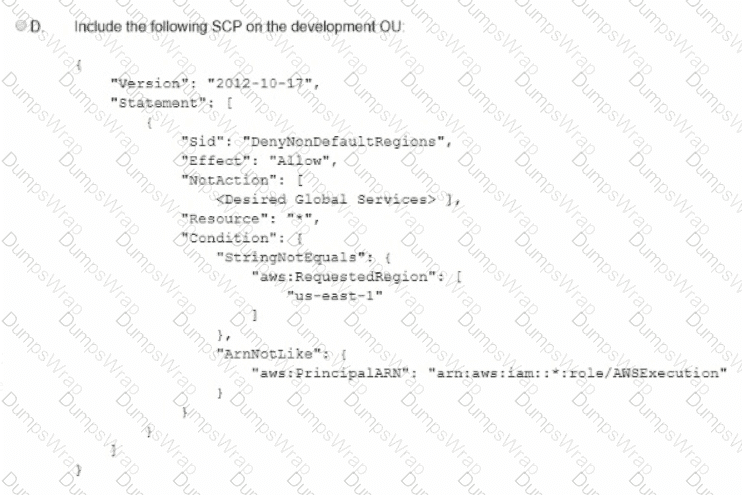
A company uses AWS Organizations and has production workloads across multiple AWS accounts. A security engineer needs to design a solution that will proactively monitor for suspicious behavior across all the accounts that contain production workloads.
The solution must automate remediation of incidents across the production accounts. The solution also must publish a notification to an Amazon Simple Notification Service (Amazon SNS) topic when a critical security finding is detected. In addition, the solution must send all security incident logs to a dedicated account.
Which solution will meet these requirements?
A company's security engineer has been asked to monitor and report all AWS account root user activities.
Which of the following would enable the security engineer to monitor and report all root user activities'? (Select TWO.)
A company is testing incident response procedures for destination containment. The company needs to contain a critical Amazon EC2 instance as quickly as possible while keeping the EC2 instance running. The EC2 instance is the only resource in a public subnet and has active connections to other resources.
Which solution will contain the EC2 instance IMMEDIATELY?
A company uses SAML federation to grant users access to AWS accounts. A company workload that is in an isolated AWS account runs on immutable infrastructure with no human access to Amazon EC2. The company requires a specialized user known as a break glass user to have access to the workload AWS account and instances in the case of SAML errors. A recent audit discovered that the company did not create the break glass user for the AWS account that contains the workload.
The company must create the break glass user. The company must log any activities of the break glass user and send the logs to a security team.
Which combination of solutions will meet these requirements?(Select TWO.)
A company is using AWS CloudTrail and Amazon CloudWatch to monitor resources in an AWS account. The company's developers have been using an 1AM role in the account for the last 3 months.
A security engineer needs to refine the customer managed 1AM policy attached to the role to ensure that the role provides least privilege access.
Which solution will meet this requirement with the LEAST effort?
For compliance reasons a Security Engineer must produce a weekly report that lists any instance that does not have the latest approved patches applied. The Engineer must also ensure that no system goes more than 30 days without the latest approved updates being applied
What would the MOST efficient way to achieve these goals?
A company has multiple departments. Each department has its own IAM account. All these accounts belong to the same organization in IAM Organizations.
A large .csv file is stored in an Amazon S3 bucket in the sales department's IAM account. The company wants to allow users from the other accounts to access the .csv file's content through the combination of IAM Glue and Amazon Athena. However, the company does not want to allow users from the other accounts to access other files in the same folder.
Which solution will meet these requirements?
A company is using an AWS Key Management Service (AWS KMS) AWS owned key in its application to encrypt files in an AWS account The company's security team wants the ability to change to new key material for new files whenever a potential key breach occurs A security engineer must implement a solution that gives the security team the ability to change the key whenever the team wants to do so
Which solution will meet these requirements?
A company plans to use AWS Key Management Service (AWS KMS) to implement an encryption strategy to protect data at rest. The company requires client-side encryption for company projects. The company is currently conducting multiple projects to test the company's use of AWS KMS. These tests have led to a sudden increase in the company's AWS resource consumption. The test projects include applications that issue multiple requests each second to KMS endpoints for encryption activities.
The company needs to develop a solution that does not throttle the company's ability to use AWS KMS. The solution must improve key usage for client-side
encryption and must be cost optimized.
Which solution will meet these requirements?
A company uses a collaboration application. A security engineer needs to configure automated alerts from AWS Security Hub in the us-west-2 Region for the application. The security engineer wants to receive an alert in a channel in the application every time Security Hub receives a new finding.
The security engineer creates an AWS Lambda function to convert the message to the format that the application requires. The Lambda function also sends the message to the application's API. The security engineer configures a corresponding Amazon EventBridge rule that specifies the Lambda function as the target.
After the EventBridge rule is implemented, the channel begins to constantly receive alerts from Security Hub. Many of the alerts are Amazon Inspector alerts that do not require any action. The security engineer wants to stop the Amazon Inspector alerts.
Which solution will meet this requirement with the LEAST operational effort?
A security engineer needs to develop a process to investigate and respond to po-tential security events on a company's Amazon EC2 instances. All the EC2 in-stances are backed by Amazon Elastic Block Store (Amazon EBS). The company uses AWS Systems Manager to manage all the EC2 instances and has installed Systems Manager Agent (SSM Agent) on all the EC2 instances.
The process that the security engineer is developing must comply with AWS secu-rity best practices and must meet the following requirements:
• A compromised EC2 instance's volatile memory and non-volatile memory must be preserved for forensic purposes.
• A compromised EC2 instance's metadata must be updated with corresponding inci-dent ticket information.
• A compromised EC2 instance must remain online during the investigation but must be isolated to prevent the spread of malware.
• Any investigative activity during the collection of volatile data must be cap-tured as part of the process.
Which combination of steps should the security engineer take to meet these re-quirements with the LEAST operational overhead? (Select THREE.)
A company has two teams, and each team needs to access its respective Amazon S3 buckets. The company anticipates adding more teams that also will have their own S3 buckets. When the company adds these teams, team members will need the ability to be assigned to multiple teams. Team members also will need the ability to change teams. Additional S3 buckets can be created or deleted.
An IAM administrator must design a solution to accomplish these goals. The solution also must be scalable and must require the least possible operational overhead.
Which solution meets these requirements?
A company stores sensitive data in AWS Secrets Manager A security engineer needs to design a solution to generate a notification email when anomalous GetSecretValue API calls occur The security engineer has configured an Amazon EventBndge rule for all Secrets Manager events that AWS CloudTrail delivers.
Which solution will meet these requirements?
A company runs workloads on Amazon EC2 instances. The company needs to continually monitor the EC2 instances for software vulnerabilities and must display the findings in AWS Security Hub. The company must not install agents on the EC2 instances.
A company hosts business-critical applications on Amazon EC2 instances in a VPC. The VPC uses default DHCP options sets. A security engineer needs to log all DNS queries that internal resources make in the VPC. The security engineer also must create a list of the most common DNS queries over time.
Which solution will meet these requirements?
A company's data scientists want to create AI/ML training models using Amazon SageMaker. The training models will use large datasets in an Amazon S3 bucket. The datasets contain sensitive information. On average, the data scientists need 30 days to train models. The S3 bucket has been secured appropriately. The company’s data retention policy states that all data older than 45 days must be removed from the S3 bucket.
An application has been built with Amazon EC2 instances that retrieve messages from Amazon SQS. Recently, IAM changes were made and the instances can no longer retrieve messages.
What actions should be taken to troubleshoot the issue while maintaining least privilege? (Select TWO.)
A company needs to retain tog data archives for several years to be compliant with regulations. The tog data is no longer used but It must be retained
What Is the MOST secure and cost-effective solution to meet these requirements?
A security team is responsible for reviewing AWS API call activity in the cloud environment for security violations. These events must be recorded and retained in a centralized location for both current and future AWS regions.
What is the SIMPLEST way to meet these requirements?
A security engineer is investigating a malware infection that has spread across a set of Amazon EC2 instances. A key indicator of the compromise is outbound traffic on TCP port 2905 to a set of command and control hosts on the internet.
The security engineer creates a network ACL rule that denies the identified outbound traffic. The security engineer applies the network ACL rule to the subnet of the EC2 instances. The security engineer must identify any EC2 instances that are trying to communtcate on TCP port 2905.
Which solution will identify the affected EC2 instances with the LEAST operational effort?
A company is using AWS to run a long-running analysis process on data that is stored in Amazon S3 buckets. The process runs on a fleet of Amazon EC2 instances that are in an Auto Scaling group. The EC2 instances are deployed in a private subnet Of a VPC that does not have internet access. The EC2 instances and the S3 buckets are in the same AWS account
The EC2 instances access the S3 buckets through an S3 gateway endpoint that has the default access policy. Each EC2 instance is associated With an instance profile role that has a policy that explicitly allows the s3:GetObject action and the s3:PutObject action for only the required S3 buckets.
The company learns that one or more of the EC2 instances are compromised and are exfiltrating data to an S3 bucket that is outside the companys organization in AWS Organizations. A security engtneer must implement a solution to stop this exfiltration of data and to keep the EC2 processing job functional.
Which solution will meet these requirements?
A Security Engineer has been tasked with enabling IAM Security Hub to monitor Amazon EC2 instances fix CVE in a single IAM account The Engineer has already enabled IAM Security Hub and Amazon Inspector m the IAM Management Console and has installed me Amazon Inspector agent on an EC2 instances that need to be monitored.
Which additional steps should the Security Engineer lake 10 meet this requirement?
A security engineer needs to analyze Apache web server access logs that are stored in an Amazon S3 bucket. Amazon EC2 instance web servers generated the logs. The EC2 instances have the Amazon CloudWatch agent installed and configured to report their access logs.
The security engineer needs to use a query in Amazon Athena to analyze the logs. The query must identify IP addresses that have attempted and failed to access restricted web server content held at the /admin URL path. The query also must identify the URLs that the IP addresses attempted to access
Which query will meet these requirements?
A security engineer is configuring a mechanism to send an alert when three or more failed sign-in attempts to the AWS Management Console occur during a 5-minute period. The security engineer creates a trail in AWS CloudTrail to assist in this work.
Which solution will meet these requirements?
A company wants to monitor the deletion of AWS Key Management Service (AWS KMS) customer managed keys. A security engineer needs to create an alarm that will notify the company before a KMS key is deleted. The security engineer has configured the integration of AWS CloudTrail with Amazon CloudWatch.
What should the security engineer do next to meet these requirements?
A company's security engineer wants to receive an email alert whenever Amazon GuardDuty, AWS Identity and Access Management Access Analyzer, or Amazon Made generate a high-severity security finding. The company uses AWS Control Tower to govern all of its accounts. The company also uses AWS Security Hub with all of the AWS service integrations turned on.
Which solution will meet these requirements with the LEAST operational overhead?
Within a VPC, a corporation runs an Amazon RDS Multi-AZ DB instance. The database instance is connected to the internet through a NAT gateway via two subnets.
Additionally, the organization has application servers that are hosted on Amazon EC2 instances and use the RDS database. These EC2 instances have been deployed onto two more private subnets inside the same VPC. These EC2 instances connect to the internet through a default route via the same NAT gateway. Each VPC subnet has its own route table.
The organization implemented a new security requirement after a recent security examination. Never allow the database instance to connect to the internet. A security engineer must perform this update promptly without interfering with the network traffic of the application servers.
How will the security engineer be able to comply with these requirements?
A company's application team needs to host a MySQL database on IAM. According to the company's security policy, all data that is stored on IAM must be encrypted at rest. In addition, all cryptographic material must be compliant with FIPS 140-2 Level 3 validation.
The application team needs a solution that satisfies the company's security requirements and minimizes operational overhead.
Which solution will meet these requirements?
A company is using AWS Organizations to create OUs for its accounts. The company has more than 20 accounts that are all part of the OUs. A security engineer must implement a solution to ensure that no account can stop to file delivery to AWS CloudTrail.
Which solution will meet this requirement?
A company runs a cuslom online gaming application. The company uses Amazon Cognito for user authentication and authorization.
A security engineer wants to use AWS to implement fine-grained authorization on resources in the custom application. The security engineer must implement a solution that uses the user attributes that exist in Cognito. The company has already set up a user pool and an identity pool in Cognito.
Which solution will meet these requirements?
A security engineer needs to implement a solution to determine whether a company's Amazon EC2 instances are being used to mine cryptocurrency. The solution must provide notifications of cryptocurrency-related activity to an Amazon Simple Notification Seivtce (Amazon SNS) topic.
Which solution will meet these requirements?
Your company uses IAM to host its resources. They have the following requirements
1) Record all API calls and Transitions
2) Help in understanding what resources are there in the account
3) Facility to allow auditing credentials and logins Which services would suffice the above requirements
Please select:
A company wants to implement host-based security for Amazon EC2 instances and containers in Amazon Elastic Container Registry (Amazon ECR). The company hasdeployed AWS Systems Manager Agent (SSM Agent) on the EC2 instances. All the company's AWS accounts are in one organization in AWS Organizations. The companywill analyze the workloads for software vulnerabilities and unintended network exposure. The company will push any findings to AWS Security Hub. which the company hasconfigured for the organization.
The company must deploy the solution to all member accounts, including pew accounts, automatically. When new workloads come online, the solution must scan theworkloads.
Which solution will meet these requirements?
A company needs a solution to protect critical data from being permanently deleted. The data is stored in Amazon S3 buckets.
The company needs to replicate the S3 objects from the company's primary AWS Region to a secondary Region to meet disaster recovery requirements. The company must also ensure that users who have administrator access cannot permanently delete the data in the secondary Region.
Which solution will meet these requirements?
A company has two AWS accounts. One account is for development workloads. The other account is for production workloads. For compliance reasons the production account contains all the AWS Key Management. Service (AWS KMS) keys that the company uses for encryption.
The company applies an IAM role to an AWS Lambda function in the development account to allow secure access to AWS resources. The Lambda function must access a specific KMS customer managed key that exists in the production account to encrypt the Lambda function's data.
Which combination of steps should a security engineer take to meet these requirements? (Select TWO.)
A company has enabled Amazon GuardDuty in all AWS Regions as part of its security monitoring strategy. In one of its VPCs, the company hosts an Amazon EC2 instance that works as an FTP server. A high number of clients from multiple locations contact the FTP server. GuardDuty identifies this activity as a bruteforce attack because of the high number of connections that happen every hour.
The company has flagged the finding as a false positive, but GuardDuty continues to raise the issue. A security engineer must improve the signal-to-noise ratio without compromising the companys visibility of potential anomalous behavior.
Which solution will meet these requirements?

